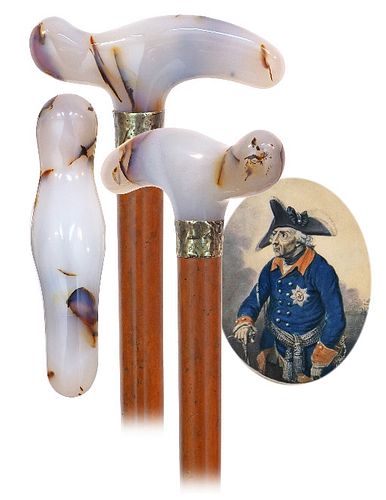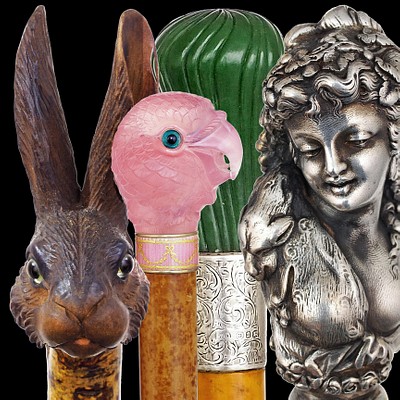Hard Stone Baroque Cane
Lot 46
About Seller
Kimball Sterling
125 West Market Street
Johnson City, TN 37604
United States
Family-owned and family-run Johnson City Tennessee auction business for 25 years. Selling antiques and collectables for 38 years. Kimball M. Sterling, Inc. was founded and is owned by Kimball and Victoria Sterling, time and again, they have laid solid claim to world-wide attention and renown with an...Read more
Categories
About Auction
By Kimball Sterling
Feb 22, 2023 - Mar 12, 2023
Set Reminder
2023-02-22 00:00:00
2023-03-12 00:00:00
America/New_York
Bidsquare
Bidsquare : Passed Cane Auction
https://www.bidsquare.com/auctions/kimball-sterling/passed-cane-auction-12307
Selection of fine canes
Kimball Sterling kimballsterling@earthlink.net- Lot Description
-Ca. 1800 -Large and voluminous dendritic chalcedony handle fashioned in a classic asymmetrically curving Baroque shape, plain silver collar with graffiti initials, malacca shaft and a 4” tall white metal ferrule. -The translucent stone shows a mystical cloudy and opalescent grey color and plenty of dark and intriguing dendritic inclusions, and its smooth and perfectly polished surface has something of á soothing and addicting feel to the touch. -The character of the handle embodies the taste of the Romantic Era and is reminiscent of King Frederick the Great of Prussia (1712–1786) canes. King Frederick, in German “Friedrich II the Great” or “Der Alte Fritz” was reputed for his interests in music, philosophy and arts and fabled his love to walking sticks. All his portraits show him wearing a cane, always a different one, yet with similarly shaped handles, hence the name “Fritzkrücke” literally translated, Fritz Handle. -Everything a collector could want, this seemingly simple, hitherto highly sophisticated cane, galvanizes the essentials of quality. It can easily gain the widespread acceptance to represent a particular and treasurable type of early German hard stone walking sticks and somehow the essence of Baroque cane art. -H. 5” x 2”, O.L. 35” -$800-$1,200 -Dendritic agate is a translucent, colorless to whitish-gray variety of chalcedony quartz, easily distinguished by its distinct brown to black markings known as “dendrites”. It is considered to be one of the rarer and more sought-after varieties and excellent varieties came from the, at that time German and today Polish, Lower Silesian mines. -The different uses of agate exploit its hardness, ability to retain a highly polished surface finish and, primarily, its decorative appeal. These have long been used in arts and crafts to make ornaments such as pins, brooches or other types of jewelry, paper knives, inkstands, seals and occasionally cane knobs and handles.
- Shipping Info
-
Each auction has different shipping terms but the buyer always pays.
Canes:
After payment has been received we will contact you.
-
- Buyer's Premium



 EUR
EUR CAD
CAD AUD
AUD GBP
GBP MXN
MXN HKD
HKD CNY
CNY MYR
MYR SEK
SEK SGD
SGD CHF
CHF THB
THB


















